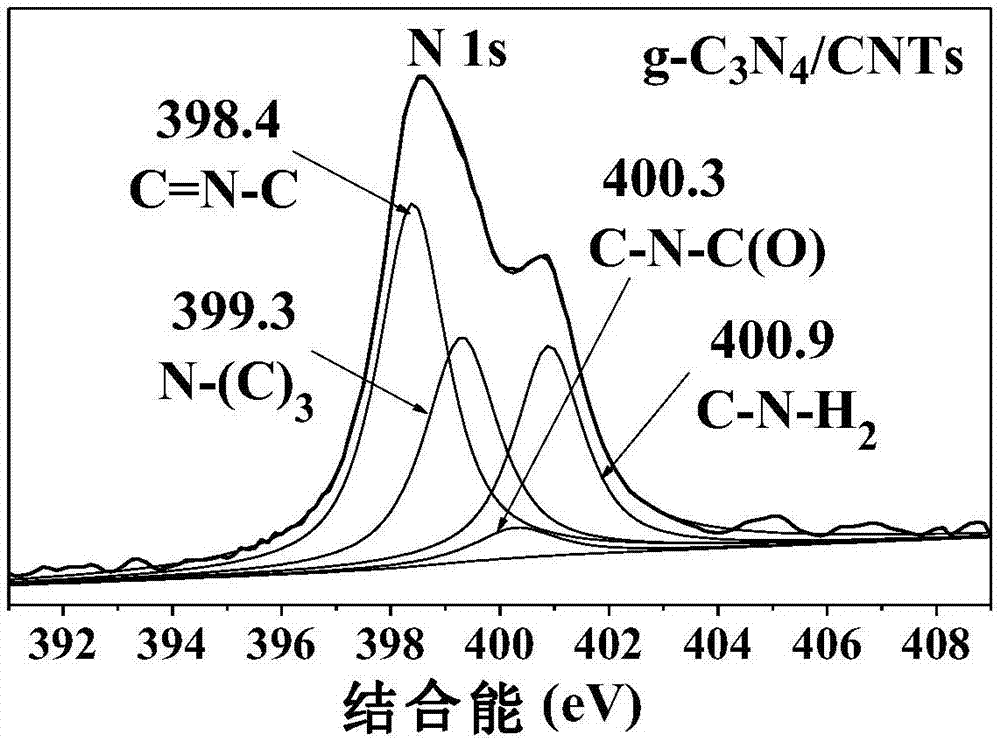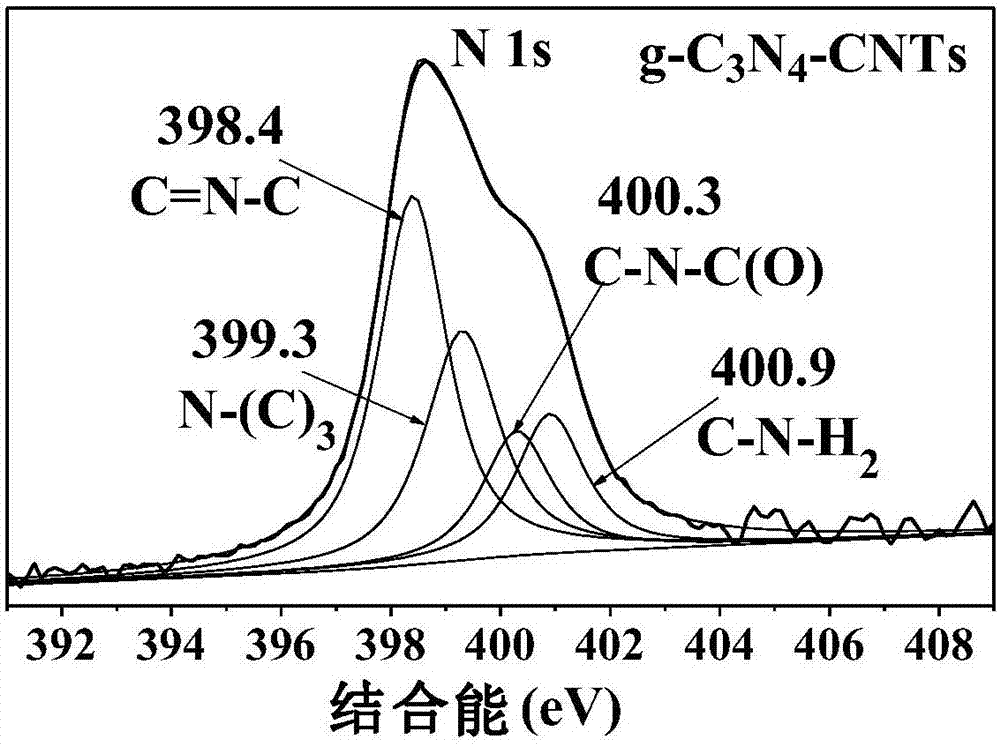g-C3N4-CNTs heterojunction photo catalyst and preparation method thereof
A photocatalyst and heterojunction technology, applied in the field of photocatalytic materials, can solve the problems of easy recombination of photogenerated electrons and holes, low photocatalytic efficiency and photocatalytic activity, and achieve high practical value and application prospects, rich in strong pollutants. The effect of gathering ability and easy availability of raw materials
- Summary
- Abstract
- Description
- Claims
- Application Information
AI Technical Summary
Problems solved by technology
Method used
Image
Examples
Embodiment 1
[0027] Example 1g-C 3 N 4 – Preparation of CNTs heterojunction photocatalyst:
[0028] (1) After uniformly mixing 30 g of melamine and 1 g of CNTs, they were placed in a tube furnace and calcined at 450 °C for 4 h in an air atmosphere to obtain g-C3 N 4 / CNTs.
[0029] (2) the g-C obtained in step (1) 3 N 4 / CNTs weighed 2.0g and added it to 40mL sulfuric acid / nitric acid (volume ratio: 1:2) mixed acid solution, reflux reaction at 40°C for 12h, washed the reacted product with distilled water and dried to obtain g-C 3 N 4 / CNTs-COOH.
[0030] (3) the g-C obtained in step (2) 3 N 4 Weigh 1.5g of / CNTs-COOH and add it to 150mL tetrahydrofuran solution, add 1g dicyclohexylcarbodiimide at the same time, heat and reflux at 50°C for 8 hours, wash and dry the reacted product to obtain g-C 3 N 4 – CNTs heterojunction photocatalyst.
Embodiment 2
[0031] Example 2g-C 3 N 4 – Preparation of CNTs heterojunction photocatalyst:
[0032] (1) After uniformly mixing 30 g of melamine and 1.5 g of CNTs, they were placed in a tube furnace and calcined at 500 °C for 4 h in an air atmosphere to obtain g-C 3 N 4 / CNTs.
[0033] (2) the g-C obtained in step (1) 3 N 4 / CNTs weighed 2.0g and added it to 40mL sulfuric acid / nitric acid (volume ratio: 1:2) mixed acid solution, reflux reaction at 45°C for 16h, washed the reacted product with distilled water and dried to obtain g-C 3 N 4 / CNTs-COOH.
[0034] (3) the g-C obtained in step (2) 3 N 4 Weigh 1.5g of / CNTs-COOH and add it to 150mL tetrahydrofuran solution, add 1.5g dicyclohexylcarbodiimide at the same time, heat and reflux at 55°C for 12h, wash and dry the reacted product to obtain g-C 3 N 4 – CNTs heterojunction photocatalyst.
Embodiment 3
[0035] Example 3g-C 3 N 4 – Preparation of CNTs heterojunction photocatalyst:
[0036] (1) After uniformly mixing 30 g of melamine and 2 g of CNTs, they were placed in a tube furnace and calcined at 520 ° C for 4 h in an air atmosphere to obtain g-C 3 N 4 / CNTs.
[0037] (2) the g-C obtained in step (1) 3 N 4 / CNTs weighed 2.0g and added it to 40mL sulfuric acid / nitric acid (volume ratio: 1:3) mixed acid solution, reflux reaction at 45°C for 24h, washed the reacted product with distilled water and dried to obtain g-C 3 N 4 / CNTs-COOH.
[0038] (3) the g-C obtained in step (2) 3 N 4 Weigh 1.5g of / CNTs-COOH and add it to 150mL tetrahydrofuran solution, add 2g dicyclohexylcarbodiimide at the same time, heat and reflux at 60°C for 12h, wash and dry the reacted product to obtain g-C 3 N 4 – CNTs heterojunction photocatalyst.
PUM
 Login to View More
Login to View More Abstract
Description
Claims
Application Information
 Login to View More
Login to View More - R&D
- Intellectual Property
- Life Sciences
- Materials
- Tech Scout
- Unparalleled Data Quality
- Higher Quality Content
- 60% Fewer Hallucinations
Browse by: Latest US Patents, China's latest patents, Technical Efficacy Thesaurus, Application Domain, Technology Topic, Popular Technical Reports.
© 2025 PatSnap. All rights reserved.Legal|Privacy policy|Modern Slavery Act Transparency Statement|Sitemap|About US| Contact US: help@patsnap.com



